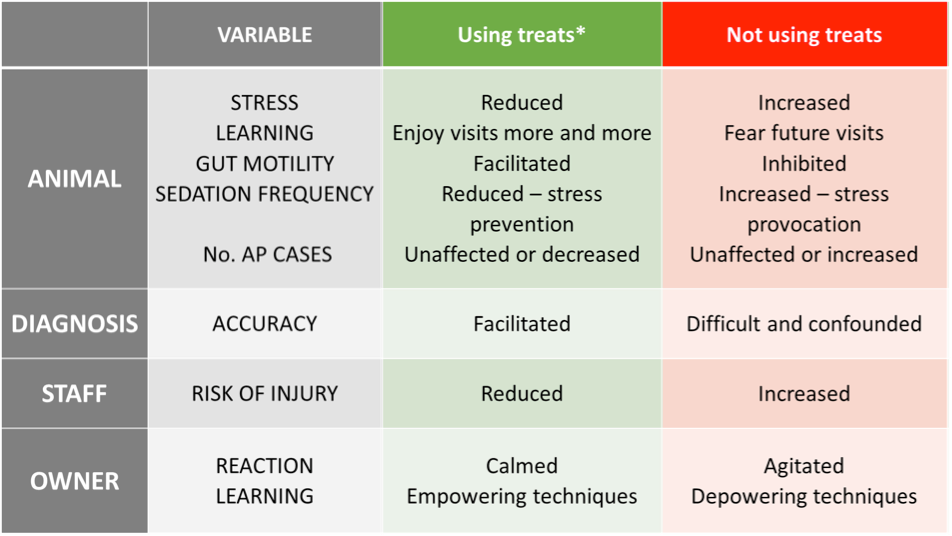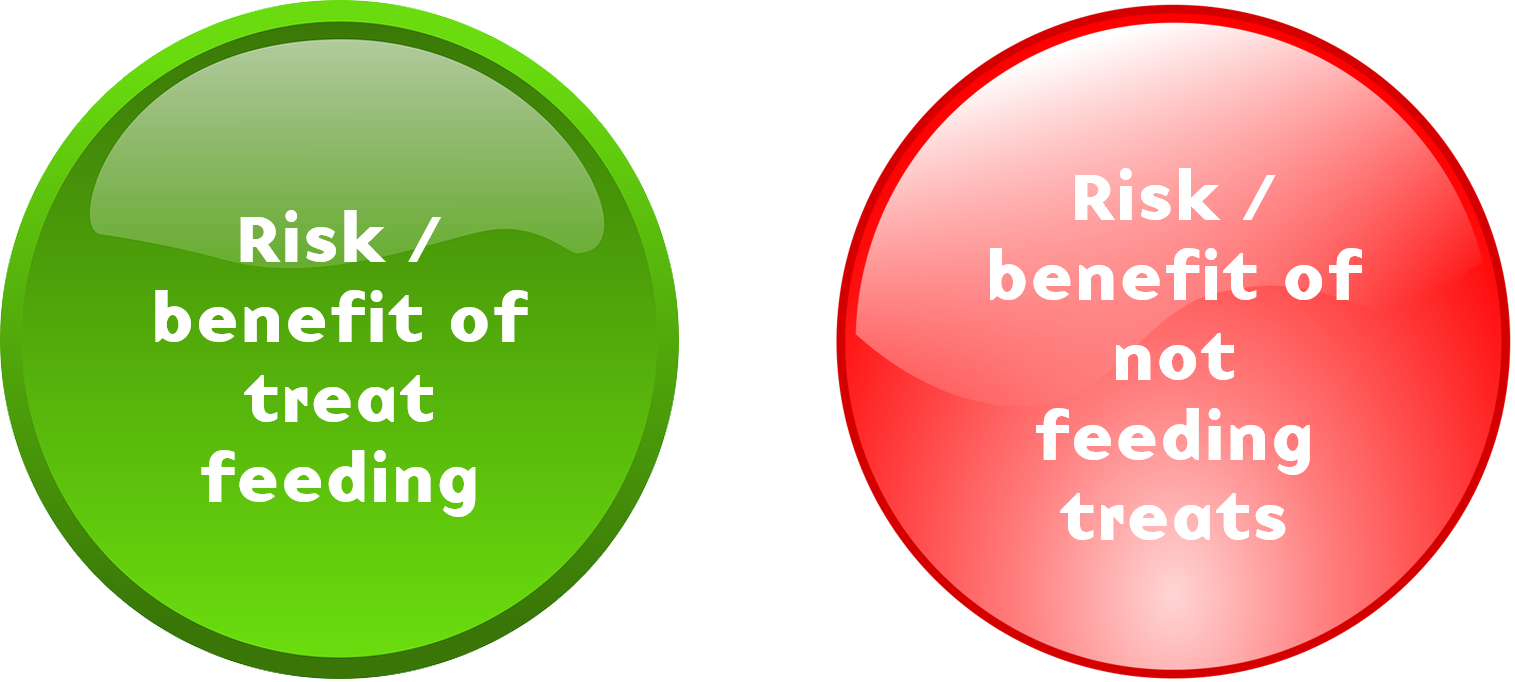This post is part of a series on addressing animals’ fear in the veterinary clinic.
Why feed treats? The technical term is counterconditioning (CC), and it’s about feeding fabulous treats in order to reduce fear.
Contrary to what many vets have assumed, there’s no evidence to indicate that it should be riskier to feed treats with the purpose of reducing fear in animals about to undergo sedation. There may be other reasons to avoid treat feeding, but that one is seemingly not valid.
Habituation (simply grabbing the animal and getting on with it, hoping he’ll get used to it) is slow, unreliable and risky. Rather, gradually introducing potentially aversive stimuli using systematic desensitization (SD) is less unsafe. The combined procedure (SD/CC) is more efficient than either procedure (SD or CC) alone.
So, should you feed or not? What are the advantages? What are the potential disadvantages?
There are mainly advantages of using SD/CC in the veterinary clinic, and mainly disadvantages of not doing so. I propose that there are at least 4 robust reasons why you should feed treats to reduce fear in the veterinary clinic, with regards to the animal, the diagnosis, the staff and the owner.

The animal.
If you or the vet are not consciously trying to prevent or reduce fear, all the available evidence suggests that the animal risks becoming more stressed on subsequent visits.
Vets often avoid treat feeding during consultations because they fear Aspiration Pneumonia if they need to sedate the animal. Hypothetically, there could be an increased risk of Aspiration Pneumonia (AP) after sedation if the animal’s stress levels are high – though this hasn’t been studied. In contrast, using treats to actively prevent or reduce fear through SD/CC should have opposite effects.
Small amounts of fluid treats shouldn’t increase the risk of AP.
The diagnosis.
When animals are stressed, their bodies respond with a series of complex short-term physiological reactions. Some of these may be mistaken for diseases that cause similar physiological reactions.
For instance, stressed cats are sometimes misdiagnosed as diabetic.
Also, if you’re successfully counterconditioning, animals become more manageable, easier to examine and diagnose, and such confounding effects may be reduced.
The staff.
Most veterinarians, vet techs and animal caretakers have been scratched, bitten or kicked by animals attempting to get away from an aversive situation. By using SD/CC, the risk of defensive aggression is reduced.
Not only may the staff be less exposed to physical risks, low-stress handling including treat feeding means animals will be more cooperative, and staff will less often have to resort to some form of manhandling in order to properly examine the animal – and this may be a source of psychological stress for the person doing the manhandling.
One important finding from a 2017 survey conducted on Fear Free certified professionals was that 80% of contestants reported improved job satisfaction.
The owner.
Some 58% of cat owners and 37% of dog owners say their animal hates going to the vet’s.
So, many animal owners avoid taking their pet to the vet, and the very thought of doing so makes 38% of cat owners and 26% of dog owners anxious.
Using SD/CC can have tremendous effect on both the animal – and the owner. For one, they might be less hesitant to bring their pet to the vet.
Additionally, the owner can learn useful techniques that may be used to reduce fear in other situations.
Conclusion.
Feeding treats at the vet’s is not pampering the animal. It reduces stress in the animal – and owner.
It reduces hazards to staff involved in handling animals.
Diagnosis is facilitated.
Finally, what are the alternatives? If staff are manhandling the animals to examine them properly and carry out procedures, owners may copy this behaviour in other situations which may impact the animal’s welfare down the line, in addition to all the problems listed here.
Exceptions? Yes. There will be situations where treat feeding is not advisable for medical reasons, but some of the risk associated with sedation is unfounded.
The reasons why animals vomit when sedated is not because they’ve eaten, it’s because they’re given anesthetics that make them vomit. Choosing another anesthetic should diminish the risk of vomiting, although, as one reader pointed out: all medications have side effects and the pet’s own physiology and health must guide the choice of sedative.
… Do you agree? If not, why? Let us know in the comment section below!
***
I give online courses on the topic of animal behaviour management, publish the odd blog post and give free webinars and masterclasses. Wanna be notified whenever any of those things happen? Sign up below!
References:
Rand et al., 2002. Acute stress hyperglycemia in cats is associated with struggling and increased concentrations of lactate and norepinephrine.
Volk et al., 2014. Bayer Veterinary Care Usage Study.
Westlund, 2015. To feed or not to feed – counterconditioning in the veterinary clinic.




My dog needed to get her annual shots during Covid and at the time the owner wasn’t allowed in with their dog. I don’t know what happened but after that visit, Taysha was petrified of even walking past that vet. I tried for 5 months to desensitize her by playing games with treats on the footpath and slowly progressing towards the door at her speed….she was still fearful. As her next lot of annual shots were coming up in 5 months I decided to find another vet (no history) and we visited 2-3 times a week (short sessions, leaving on a high), just to play, have fun and enjoy her favorite treats in abundance and slowly introduce the consult room and staff, all at Taysha’s pace.
One of her ‘Hot Zone’ mats came with us, so she had a safe/familiar place and also a target especially on the consult table. I also practiced examining her at home before trying it out at the vets. Anyway, her 2 ‘real’ visits went super well. Always happy to visit this vet, Taysha happily got up on the table to be examined, didn’t even realize she had an injection…..too busy eating cheese/roast beef. Played with the staff whilst I paid the account. So proud of her and so happy it wasn’t stressful for her.
How about play before and/ or after vet visits with my fearfull dog?
I feed treats in abundance, trained my dog a certain way to undergo all kind of touches with naming and explaning and counting to 10, after which he is allowed to relax. He accepts it from me. If the vet does the same he allows the examination. But most vets don’t or say they do but then ‘routine’ takes over and they forget to do as I asked. So then he snaps.
So I tried play in the waitingroom. He likes it, seems happy with it , but I wonder if it adds to his stress?
Elise, that must be frustrating when these well-meaning vets forget to do as asked..! Perhaps you could help cue them, or show them a video of what it looks like?
As to playing, that typically does increase arousal more than food, and for some volatile animals they may then more easily switch into negative high arousal. So the answer would be “it depends”, I’m thinking..! 🙂
Thank you Karolina, for your reply.
Either way: since playing in the waitingroom, he has no problems going in there. He loves to play. He does not SEEM more stressed. What I was thinking also is the thing I read in one of your blogs or emails or courses: emotion infect backwards (?) I was afraid the playing would become less fun because the vet comes after. But he still loves to play. So no harm done there 😉
Sorry for my English. I am Dutch.
Thank you for thinking about it. It is a big problem for us.
Emotions do infect backwards, and you can use that at the vets. Parking in the parking lots leads to play. Entering the reception room leads to play. Getting on the scale leads to play. Entering the examination room… Getting on the table… if it’s a big concern you can repeat this a number of times without actually anything scary or uncomfortable happening. That leads to latent inhibition; a reduced risk of later fear learning. Best of luck!
My dog is so shut down with fear at the vet’s that she won’t even eat her favourite treats. It’s not nice but she has ongoing issues and needs regular visits. Difficult all round. And yes, I myself am stressed about it!
You say that habituation doesn’t work but desensitisation does. But how to desensitise this complex experience? It ain’t toenail-clipping, that’s for sure!
Thank you for this blog.
Habituation works in some scenarios, but in the vet scenario there’s trigger stacking, so the type of habituation that is more likely to succeed is systematic desensitization, ideally in combination with counter conditioning. If possible, find the triggers and work with then one by one, alone first and later in combination. An animal who is shut down is very difficult to train – can you try visiting another veterinary clinic that doesn’t carry the same learning history?
I only have one…. Complaint about giving treats. My dog is highly food driven, almost to a fault. He LOVES going to the vet. So much so that we can’t go by without him getting excited/anxious and becoming crazy excited to get in the door to see the staff.
It’s a little nuts since he’s a SDiT and this is the only place where he acts that way.
I’m grinning… I apologize- I realize this could actually be quite problematic, but it is pleasing to hear that your dog likes going to the vet!
Perhaps you could try to diminish some of the enthusisasm by eliminating some of the contrast. So – getting some of those fabulous treats OUTSIDE the vet context. Or reinforcing calm behaviour. Or using lower value treats. Or reinforcing with petting instead (assuming it’s also reinforcing). I have a friend who works a lot with “on/off” exercises – alternating between excited play and relaxation… Good luck!
I support the heavy use of treats, along with a lean, hungry pet during veterinary visits. Anesthetics, anesthesia pre-medications, and sedation are three seperate concerns, even when the same drug might be used in each circumstance. The selection of these medications relies on many more variables than simply ‘pick a different med.’ as a doctor, I must consider the potential risks to the patient, their systemic wellness, the support available during treatment, and the treatment needed. Please do not simplify this decision process by suggesting the fault is in the doctor selecting a drug that has nausea as part of the profile, rather recognize that all medications have side effects and the pet’s own health and physiology must guide those choices. Unless your license (do PhD’s need a license to issue medical advice) is on the line and you understand these complexities, please respect that there will be times that even is treat heavy, low stress, aiming towards fear free vets will need to advise owners to not use treats for the well being of their pets, and it isn’t as simple as ‘choose another med.’
Dear Summer, I wrote this blog post in order to address a situation that the majority of pet owners face when visiting the veterinary clinic. A) no treats are given; and B) emetic compounds are routinely used when sedating animals. While there are situations where both A and B may be warranted for medical reasons, I wanted to lift the issue of A) the benefit / risk tradeoff of treat giving vs abstaining from treat giving; and B) there are available alternatives to emetic compounds that may be used if the situation permits. In my paper published in the Journal of Veterinary Behavior (the Westlund reference) I list non-emetic alternatives that may be considered for each level of sedation (anxiolytics/tranquilizers, antidepressants, analgesics, anesthetics), mentioning that there may be side effects other than whether they cause vomiting that may influence decision making. I’m glad you brought to my attention that the post came across as over-simplistic. I’ve now rephrased the post to reflect some of these aspects of decision-making. //Karolina
Feeding treats is especially important in puppy visits. I teach large breed puppy’s to hop onto the lift table. By the time the 6 mo puppy comes in they charge to the table and sit on it. Owners are amazed that their dogs forever enjoy coming to the vet.
Excellent article.
Sounds great, thanks for sharing! I’m glad you liked the article! //Karolina